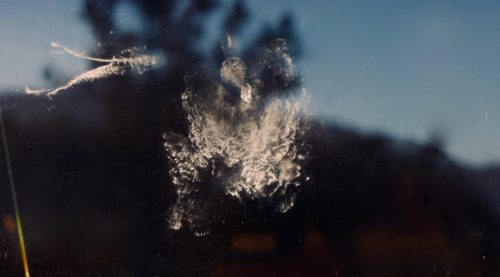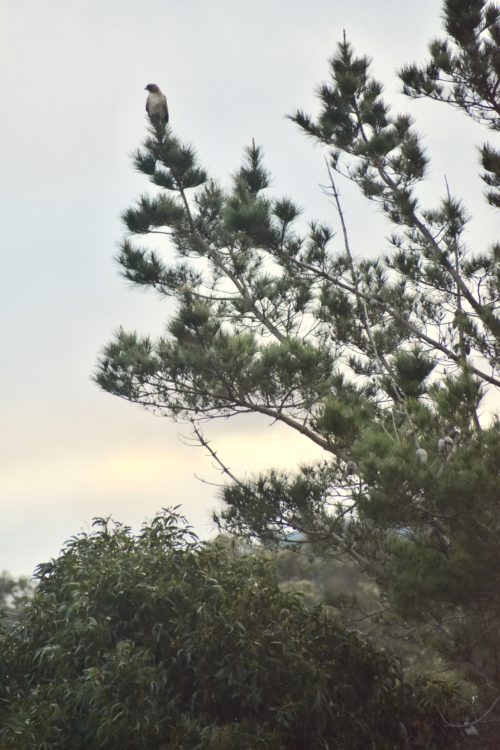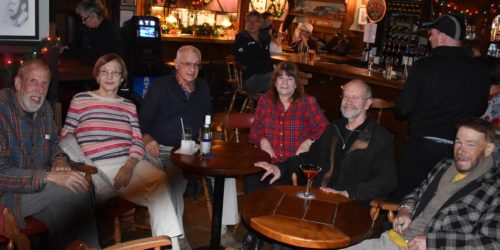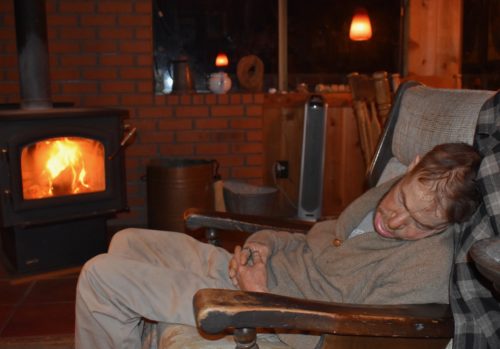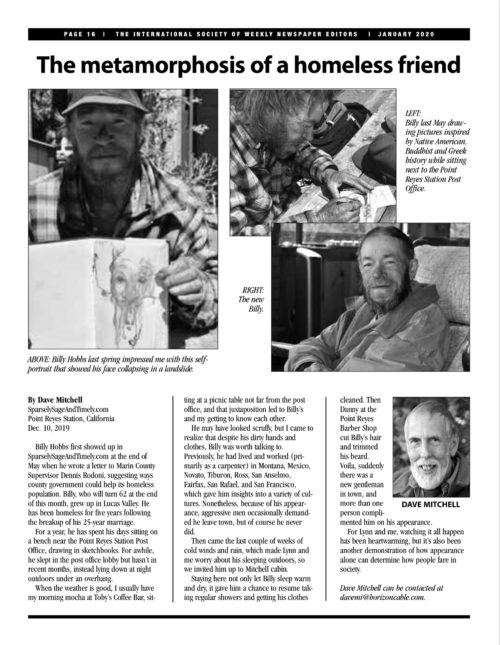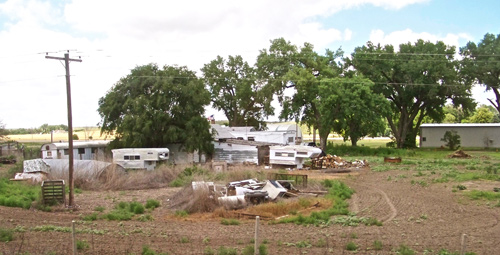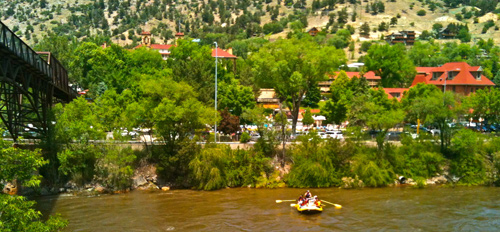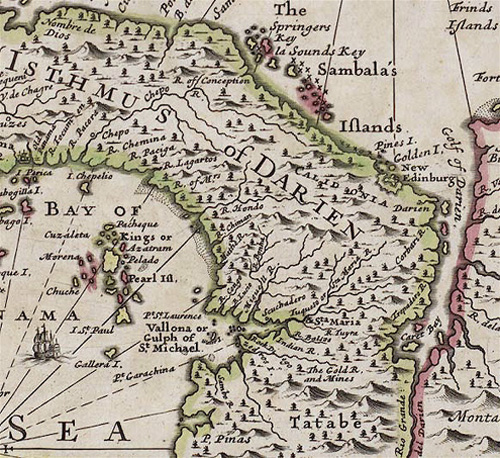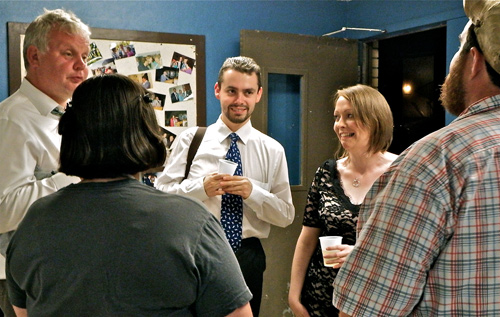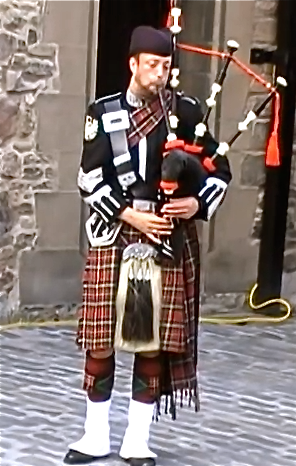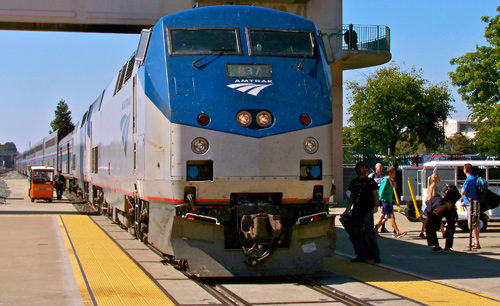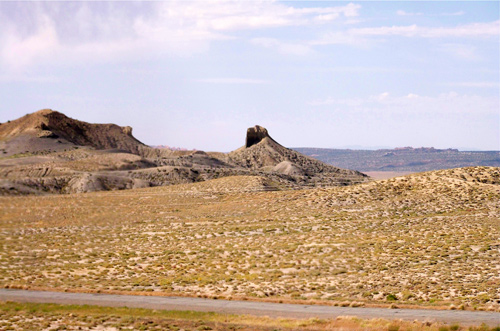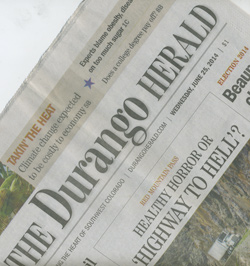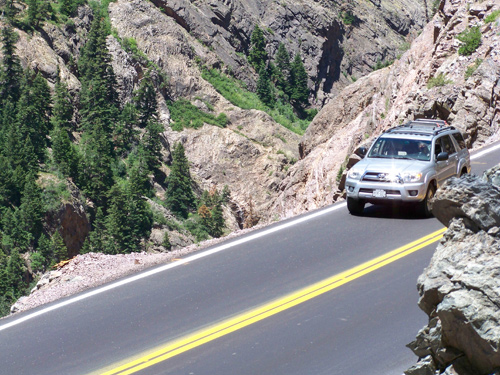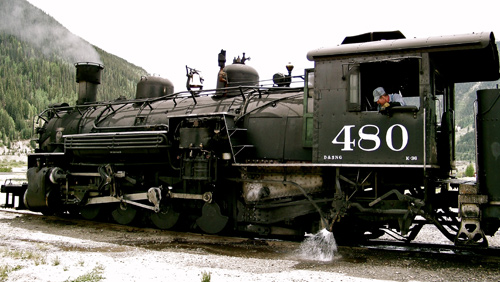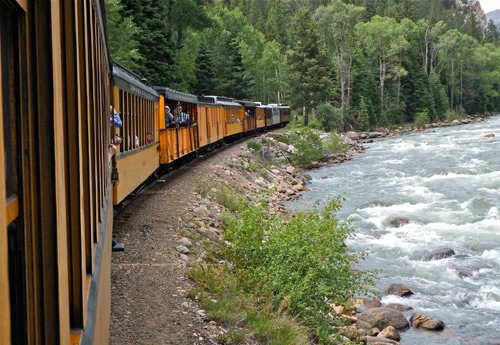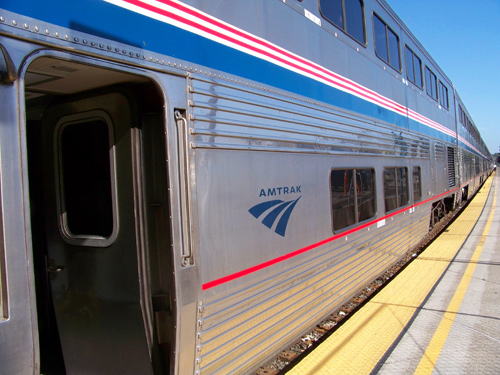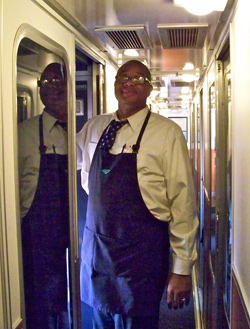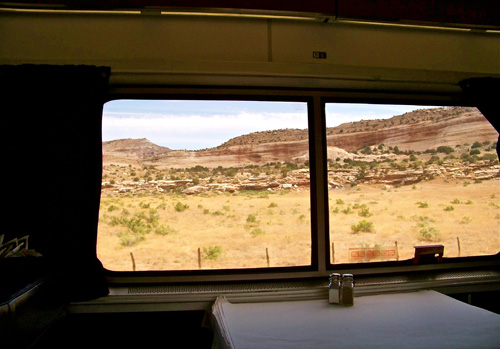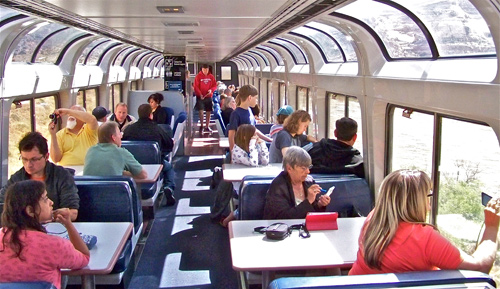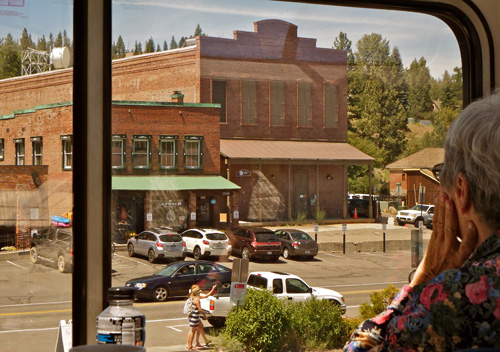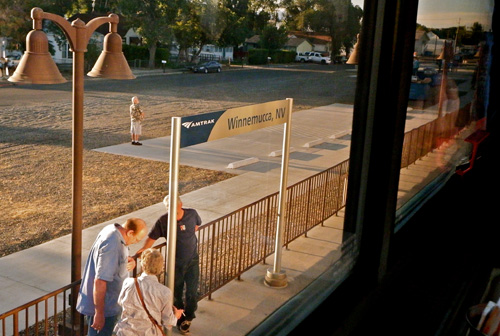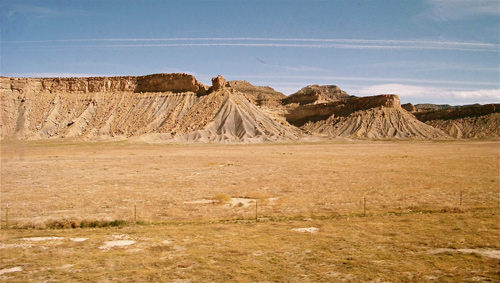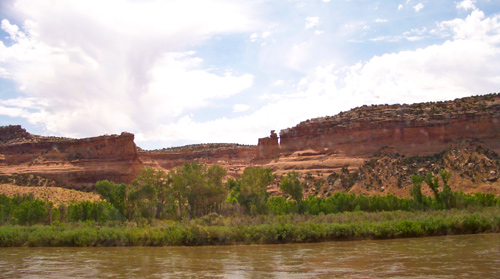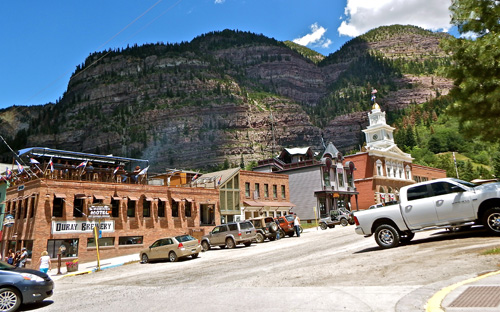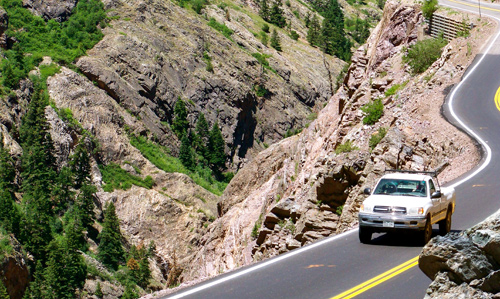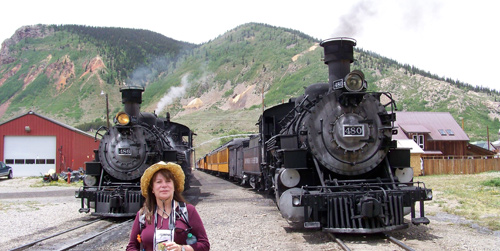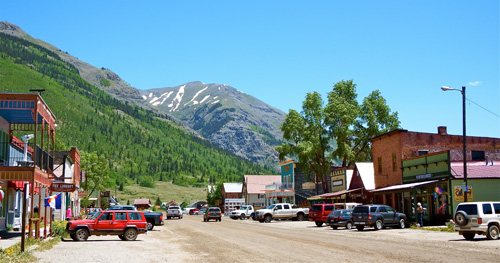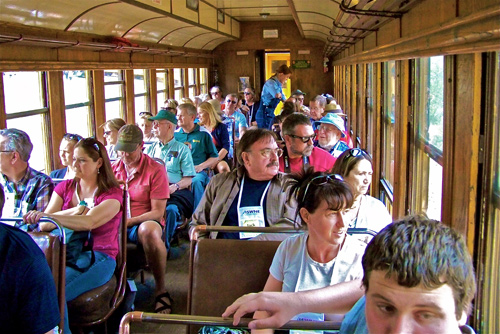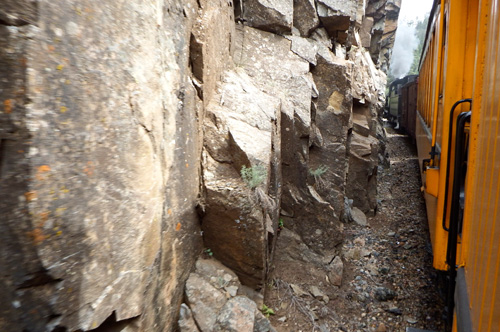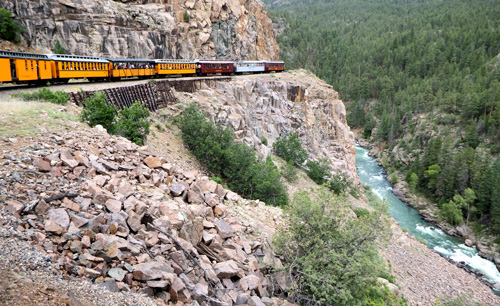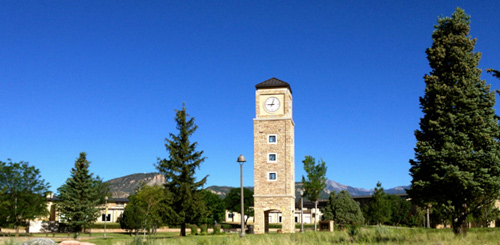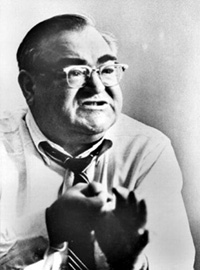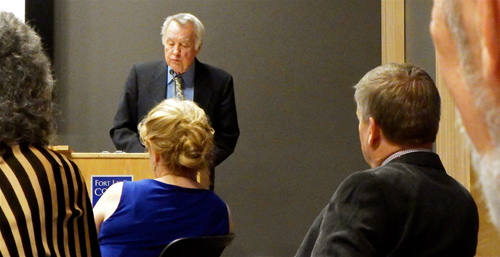Entries tagged with “International Society of Weekly Newspaper Editors”.
Did you find what you wanted?
Sat 23 Oct 2021
Caveat lectorem: When readers submit comments, they are asked if they want to receive an email alert with a link to new postings on this blog. A number of people have said they do. Thank you. The link is created the moment a posting goes online. Readers who find their way here through that link can see an updated version by simply clicking on the headline above the posting.

Billy Hobbs holds a croton houseplant my wife Lynn gave him Wednesday as a house-warming present.
A NEW DAY has dawned for a long-time-homeless resident of Point Reyes Station, Billy Hobbs. Billy, who was homeless for seven years following the breakup of a 25-year marriage, is now housed.
Thanks to the California Section 8 Housing Program, Billy two weeks ago moved into a pleasant, one-bedroom apartment in San Rafael. The second-floor apartment comes with a fireplace and the deck on which he is standing above.
In his younger days, Billy, now 63, worked in construction, house painting, agriculture, and more. In recent years, however, he’s occupied himself with art.

Here he is seen drawing outside the Point Reyes Station postoffice two years ago.
Billy Hobbs was sleeping outdoors in Point Reyes Station when the rain and cold winds hit two winters ago, so Lynn and I offered to let him wait out the bad weather in Mitchell cabin. Once he did, Billy was able to resume showering and getting his clothes cleaned regularly. Add to that a haircut and a beard trim, and he had dramatically cleaned up his act.
This past winter, I parked my second car (since donated to KQED) on Mesa Road downtown for him to sleep in; the car had to be moved every 72 hours to comply with the law. Earlier this year, he stayed briefly in a San Rafael motel at county expense. His Section 8 housing is funded by the US Department of Housing and Urban Development.
By now, Billy’s situation is known to editors around the world. A posting I wrote about Billy two years ago was reprinted by the International Society of Weekly Newspaper Editors and distributed among members in the United States, Canada, the United Kingdom, Ireland, France, Australia, South Africa, Nepal, and China. And these reprints do get read. A reprint of my Aug. 20 posting, in which I mentioned breaking my shoulder falling on the stairs, drew a get-well message from France.
I know of folks who have been on the waiting list for Section 8 housing 20 years, so Billy would probably appreciate it if readers who know a bit about his story wrote to congratulate him on his new home: 100 Laurel Place, Apt. 17, San Rafael, CA 94901.
Tue 21 Jan 2020
Posted by DavidMitchell under Personal, Point Reyes Station, West Marin nature
Comments Off on Becoming an internationally known artist
Caveat lectorem: When readers submit comments, they are asked if they want to receive an email alert with a link to new postings on this blog. A number of people have said they do. Thank you. The link is created the moment a posting goes online. Readers who find their way here through that link can see an updated version by simply clicking on the headline above the posting.

Silverfish are one of the oldest insects and may predate the dinosaurs by 100 million years. By now they’ve evolved into household pests that eat documents, photos, and clothes. So while I’m usually displeased at seeing a spider in the shower stall, I forgave this one because of his taste for silverfish.

Another encounter at home. A dove left its image when it crashed into the living-room window last week. Although initially dazed, the bird eventually few off.

A red-tailed hawk perches at sunset downhill from Mitchell cabin.

Waiting for the music at the No Name Bar in Sausalito a fortnight ago. Sitting from the left next to me are Friday night regulars Vivian and Ray, my wife Lynn, Paul Leclerc, and in recent weeks Billy Hobbs.

Sitting by the fire. Billy had been homeless for five years and was sleeping outdoors in Point Reyes Station when the rain and cold winds hit two months ago, so Lynn and I offered to let him wait out the bad weather in Mitchell cabin. Once he did, Billy was able to resume showering and getting his clothes cleaned regularly. Add to that a haircut and a beard trim, and he had dramatically cleaned up his act.

Resting indoors by our woodstove. Being warm, clean, and well fed led to quite a metamorphosis for Billy, as regular readers of this blog know. Now his story has been read worldwide.

This week, his story reached journalists around the globe, not only throughout the United States and Canada but as far away as Ireland and Nepal, when the International Society of Weekly Newspaper Editors (ISWNE) republished my Dec. 10 posting. In short, Billy has now become an internationally known artist.
Mon 6 Jul 2015
Lynn and I took Amtrak halfway across the country and back three weeks ago on a frustrating trip that went nowhere but cost a fortune to get there.
Here’s what happened. I am a member of the International Society of Weekly Newspaper Editors, which this year held its annual conference in Columbia, Missouri. The conferences move around. Next year’s will be in Australia. Last year’s was in Durango, Colorado.
Lynn’s and my conference fees came to $1,250, but we considered it money well spent. Last year’s conference was the first we had attended, and both of us were impressed by the community-newspaper editors from around the world whom we met.
Organized discussions ranged from newspaper ethics to how to cover major disasters. Moreover, the group presented me with its Eugene Cervi Award for my years as an editor, and I returned to West Marin just glowing.
This year’s conference was scheduled for June 24 to 28 in Columbia. Lynn and I decided to travel by Amtrak as we had last year, for we had thoroughly enjoyed the ride. We would take the train to Ottumwa, Iowa, rent a car, and drive the rest of the way to Columbia, so we reserved a sleeper compartment for $1,329 roundtrip.
However, as I’ve noted here before, a year ago I came down with temporal arteritis (an inflammation of the artery in one’s temples that feeds blood to the eye). Left untreated temporal arteritis can cause blindness, so the doctor put me on a 10-month regimen of Prednisone (a steroid). As the months went by, he had me slowly taper off on the dosage until it got down to nothing just before we left for Columbia.
There are numerous problems with Prednisone, however, and in my case one side effect was being constantly weary. Another was frequently losing my sense of balance. Falling down on stairs became commonplace but caused no serious injuries. However, a fall while weed-whacking on Memorial Day and another fall at the end of May bruised my ribcage to where it became painful to walk.
Nonetheless, Lynn and I were determined to travel to Missouri for the newspaper conference. We already had a roundtrip ticket to Ottumwa on Amtrak, and we reserved a car from Enterprise in Ottumwa for $175 per day.
And so it was that on June 22 we drove to the Amtrak station in Emeryville where our train was more than an hour behind schedule, but Amtrak is notoriously late much of the time, so we thought nothing of the delay. Because Amtrak doesn’t own the tracks it travels on, its trains have to give way to any freight trains that come along.
Our engineer was trying to make up time, we were told, but the train was about four hours behind schedule by the time we reached Colorado. And in Colorado things really slowed down. Track maintenance caused more than a few delays, and when we finally reached Nebraska, these delays seemed nonstop.
Part of the problem resulted from a rainstorm in Illinois, Iowa, and Nebraska. In some places the tracks were flooded, and in others, springs gurgled up between the rails.

The view along the tracks in Nevada sometimes seemed a pretty good symbol of our Amtrak trip. (Photos by Lynn Axelrod)
We crept through western Nebraska, getting a good chance to inspect everyone’s back yard. They’re much tidier in Nebraska than in Utah, Nevada, and California where abandoned car parts and dilapidated buildings dominate the scenery in a some places.
I slept most of the way but got up three times a day for meals. After a couple of days, however, the lurching of the train was aggravating the pain in my ribs. Getting to the dining car or the restrooms required walking down narrow corridors in several cars, and despite trying to be careful, I was occasionally thrown against the walls of the corridor.
So I downed a bunch of Ibuprofen. Bad idea. With nothing such as yogurt available to buffer the painkiller, I was sick as a dog by the time we reached Ottumwa. That convinced us to spend the night in a hotel before traveling on. We rented a room near the train station for $90 per night, and I climbed into bed. Lynn meanwhile headed out to pick up the Enterprise rental car we had reserved. The agency, however, told her that because of the rainstorm, no vehicles were available or would be for several days .
Hertz was out of cars too, but Lynn finally found a family business that had a car for rent at $220 a week, and she took it. By the next morning, however, I was ready to go home. My stomach was still queasy, and my walking was reduced to shuffling because of my balance problem.
Amtrak told us the next train west would be that evening, and the only compartment available was a “family room,” which provided more space for stretching out but cost an additional $822. We bought a ticket and returned to the hotel to sleep all day for an additional $90.

Glenwood Springs along the Colorado River was one of the more attractive towns where the train stopped.
When we arrived at the Ottumwa train station that evening, Lynn and I encountered a new set of problems. Our train couldn’t get to Ottumwa because of the bad weather, so we would be put on a bus for a four-hour ride to Omaha where we would catch the train which would arrive from Chicago by a circuitous route. We had become resigned to our fate and agreed to the arrangement.
The bus was full of Amtrak passengers, and when we all got to Omaha about 11:30 p.m., we learned our train wouldn’t arrive until the next morning. Lynn and I were irritated. Several passengers who were heading to the airport in Denver were angry about missing their flights. Much of the throng spent the night in the train station. Lynn and I rented a hotel room nearby for $188.
The next morning Lynn and I arrived at the Amtrak station early only to have our train show up an hour and a half late. Our family room was relatively comfortable for resting. That was good because we kept falling further and further behind schedule. The delays were felt even in the dining car which began running out of various foods.
Amtrak serves good fare, but at the end of the trip all it could offer for our last meal was a bowl of rice with three spoonfuls of beef stew on top. The good part was that we were always seated with other passengers who inevitably were intelligent, friendly people.
Twelve hours behind schedule our train finally rolled into Emeryville, and just over an hour later we rolled back into Point Reyes Station. Unfortunately when we began unpacking, we discovered we’d left a $500 camera and a $40 pocket knife on the train. Lynn called Amtrak, but no one had turned them in. At least no one broke into our house while we were gone, we told each other, but then we discovered our stapler was missing. I just about became unstuck.
Our trip to the Midwest had cost more than $4,400, but I wouldn’t have minded had we actually reached the ISWNE conference. From what I’ve now read in ISWNE’s report on the event, those who did make it had a very good time and learned a lot.
Sun 5 Oct 2014
Posted by DavidMitchell under General News, History
1 Comment
Little did I realize four years ago when I wrote a posting about Scotland’s ill-fated attempt to establish a colony in Panama that I was telling the backstory to last month’s referendum on Scottish independence.
On Sept. 19, Scots voted 55.3 percent to 44.7 percent to remain in Great Britain and not become an independent country. Given most coverage in the US press, readers could have easily missed the fact that Scotland had previously been independent, but when a nationwide get-rich-quick scheme went awry, it lost its independence.
I’m going to let a Scottish journalist, whom I met this summer, describe the significance of the vote against independence. First, however, here’s an excerpt from my Sept. 14, 2010, posting that gave the backstory.
Scotland was an independent kingdom from 843 when it was unified until 1707 when it became part of the Kingdom of Great Britain. As an independent country, Scotland during the 1600s had imperialistic ambitions in the Americas. It tried unsuccessfully to establish colonies in Nova Scotia, East New Jersey, and South Carolina, but the worst disaster occurred in Central America.
In the late 1690s, the Scots attempted to establish the colony of New Caledonia on the Isthmus of Panama. A series of crop failures had caused Scotland to look for an overseas source of income. Enter financier William Paterson with a scheme for establishing a colony at Darien in Panama. It would be a way to facilitate trade with the Far East and with European colonies on the west coast of the Americas.

The site of the Darien colony is shown just to the left of the word ‘Darien’ in the ‘Gulf of Darien’ on the right side of this map from 1699.
Despite no one really knowing how all this could be done, the Company of Scotland was chartered in 1695 to raise money to finance the scheme. The company’s first expedition to Panama in 1698, however, ended in disaster. About 1,200 colonists sailed for Panama, but because of disease and starvation, only about 300 survived. Of the five ships that had made the crossing, only one was able to return to Scotland the following year.
Unfortunately, a second expedition had unwittingly set sail before the remnants of the first arrived home. The second group tried to rebuild what the first group had abandoned, as well as complete a fort for defense against the Spanish. And the Spanish did indeed attack. The Scots were briefly able to hold them off but were ultimately forced to surrender. By then, most of the colonists who had joined the expedition had died of dysentery or other diseases. Only a few hundred (out of about 1,300) made it back to Scotland.
The economic effect of these failures devastated Scotland. Citizens from all levels of Scottish society had invested in the Darien scheme, and estimates of their combined losses range from a fifth to nearly a half of all the wealth of Scotland at that time. Many Scots were left indebted and impoverished.
Desperate to recover, in large part by sharing in England’s international trade, the Scots agreed to the 1707 Acts of Union, which created Great Britain as a political union of England and Scotland.

The Scottish contingent at the International Society of Weekly Newspaper Editors (ISWNE) annual conference, which was held in Durango, Colorado, last June. From left: Julian Calvert, senior lecturer at Glasgow Caledonian University, having previously edited newspapers in England and Scotland; Scott Reid, group production journalist for the daily Glasgow Herald and the weekly Sunday Herald, both national Scottish papers; Roisin McGroarty, editor of the weekly Irvine Times on the west cost of Scotland and publisher of a quarterly magazine, the Stewarton Advertiser. (Photo by Lynn Axelrod)
While in Durango, I had the honor of receiving ISWNE’s Eugene Cervi award for career achievement and also gave a talk based my new book, The Light on the Coast: 65 Years of News Big and Small as Reported in The Point Reyes Light. Lynn and I met scores of editors from throughout the English-speaking world.
Among the foreign journalists we met was Scott Reid of Scotland (above center). Interestingly, he works for a pair of sister newspapers that took opposing positions in their endorsements regarding Scottish independence. In the wake of the referendum’s defeat, Reid has given his fellow ISWNE members a copy of his observations to share.
This little country cannot be taken for granted
By Scott Reid
For more than two years, those of us working in Scottish journalism have been privileged to have a front row seat as history was made in our country.
The nation faced a simple question: Should Scotland be an independent country? The answer wasn’t so simple. And the tale of how Scotland, a nation of five million people, at one point looked on the verge of making a decision that would send shockwaves around the world will be talked about for decades to come.
To say the Scottish people were transfixed by the prospect of independence from the outset would be to lie, frankly.
 Scott Reid, who wrote these observations, (right).
Scott Reid, who wrote these observations, (right).
The Scottish National Party (SNP), which has campaigned for independence for Scotland from the U.K. for many decades, won a landslide majority in the Scottish Parliament in 2011 because it had governed well for the previous term, rather than due to any great interest in this particular policy.
An agreement with Westminster was made for a referendum to be held. And most people, while appreciating the historic nature of this, got on with their lives.
In the months leading up to the vote, the atmosphere changed. In May, a paper I work for, the Sunday Herald, backed a Yes vote. This was no overnight switch; the tone of the paper had been moving in that direction for some time. The response was incredible. Sales rocketed and continued to fly as the weeks went on. In one recent week after the referendum sales of the paper year-on-year actually doubled to 49,291.
After two television debates between Alex Salmond of the SNP and former U.K. chancellor Alistair Darling of the No camp, one which was broadcast around the world and even picked up by C-Span, huge viewing figures showed that the public was now on-board with this process.
 “I firmly believe that distance adds enchantment to the bagpipes.” William Butler Yeats’ jest, not Scott Reid’s
“I firmly believe that distance adds enchantment to the bagpipes.” William Butler Yeats’ jest, not Scott Reid’s
After the second debate, won by Salmond, the No campaign had a wobbly period. The polls narrowed. There was something in the air. I increasingly wondered if change was afoot.
Then a poll showed Yes ahead. 51% to 49%. And all hell broke loose. The markets shook, there was talk of both the U.K. Prime Minister and the U.K. leader of the opposition having to resign if they lost the vote, the issue dominated the front pages of papers in Scotland and throughout the U.K., and clearly had an impact beyond.
In response, the Prime Minister, Deputy Prime Minister and leader of the opposition charged up to Scotland to try to retrieve the situation and offer Scots more powers for the Scottish Parliament.
Throughout the final weeks, our papers were dominated by the referendum. On a daily basis The Herald contained 10 full broadsheet pages on the topic, featuring news, columnists, and occasionally four pages full of letters. The Sunday Herald, which had declared its position early doors, was also dominated by the topic.
Counter to its Sunday sister paper, The Herald decided to back the No side a few days before the vote after Westminster leaders promised extra powers for the Scottish Parliament. However, it warned that if much enhanced extra powers for the Scottish Parliament promised were not delivered then another referendum should follow suit, and the No side would deserve to lose.
It was an articulate case and one that even met with approval from many of those on the Yes side. Both papers have different editors and were given free reign by their owners to come to their own conclusions.
After such a build-up, referendum results day itself was a bit of an anti-climax. Soon after polls closed at 10 p.m. it became brutally clear this wasn’t going to be a nail biter. The head of polling company YouGov pointed to new figures suggesting No would win and said he was 99% certain the survey was accurate. As much as there were doubts over the polls for much of the campaign, for someone to put his neck on the line that far told its own story.
 Then from the minute the first result came in and Clackmannanshire was the centre of the world’s attention, it was obvious. That area was designated by many as a guaranteed Yes vote; it went the other way.
Then from the minute the first result came in and Clackmannanshire was the centre of the world’s attention, it was obvious. That area was designated by many as a guaranteed Yes vote; it went the other way.
Scott Reid (right) believes the referendum was good for Scotland. (Photo by Lynn Axelrod)
We set to work putting out several editions throughout the night, culminating in an 8 a.m. special edition, our work being rewarded by huge sales increases throughout that week well ahead of the Scottish market.
In the end, the result came in as 55% No, 45% Yes. So was there any point? Well, yes. It opened up a debate about who we are and what kind of country we want. It engaged almost the entire population in politics.
It proved that, when people know every single vote counts and it’s an issue they really care about, they will come out in numbers. It allowed voting for 16 year olds and 17 year olds, which proved to be such a success I suspect it will be carried over to regular Scottish Parliament elections.
And it has worked in Scotland’s interests, as it has made it clear that this little country in the north of the U.K. cannot be taken for granted.
Sat 12 Jul 2014
With airlines becoming increasingly unpleasant, airport security treating passengers as suspected terrorists, flight attendants abusing fliers, and seats too close together to sit comfortably, there are better ways to travel.
Three weeks ago when Lynn and I traveled to Durango, Colorado, we saw no need to let an airline ruin an otherwise happy trip, so we didn’t. It was a good decision.

On the first part of our journey, we rode Amtrak from Emeryville to Grand Junction, Colorado.

Our roomette gave us space to stretch our legs and to sleep lying down. Unlike airlines that travel at roughly 30,000 feet, trains travel at ground level, and the scenery we passed through, such as this stretch of Utah desert, was spectacular.
_________________________________________________________________
 From Grand Junction, we drove almost 150 miles to Durango.
From Grand Junction, we drove almost 150 miles to Durango.
South of Ouray, Colorado, Highway 550 crosses Red Mountain Pass, and last year USA Today described that section of highway as one of the “world’s 12 most dangerous roads.”
As The Durango Herald reported while we were in town, it shares that distinction with the “Highway of Death in Iraq” and “Death Road” in Bolivia.
_________________________________________________________________

“Red Mountain Pass, per mile, has the highest avalanche hazard on the North American Continent,” The Durango Herald added. “The narrow, two-lane road winds through the mountains like a drunk crazily stumbling, and there’s no guardrail to protect cars attempting hairpin turns from hurtling into the jagged ravines that lie, stunning and ominous, hundreds of feet below.”

While Amtrak locomotives, of course, burn diesel fuel, steam locomotives still burn coal. The International Society of Weekly Newspaper Editors (ISWNE), whose conference Lynn and I were attending, took an excursion on the 132-year-old Durango and Silverton Narrow Gauge Railroad from Silverton to Durango. I had as much fun as a kid with a Lionel Train set.
While trains in general are rich in history, steam engines are especially rich in nostalgia, even for the trainmen. Our engineer, Mike Nichols (seen releasing extra water for making steam), has been on the run for 43 years.

The route of the Durango and Silverton Railroad provided spectacular scenery of its own. Some passenger cars on the train have traditional, enclosed seating while some are open-air for enhanced sightseeing.

You may recall Arlo Guthrie’s hit, The City of New Orleans, in which: “The conductor sings his song again: the passengers will please refrain….” The line may be an allusion to a ribald ditty that folk legend Oscar Brand popularized with a 1956 recording. Sung to the tune of Dvorak’s Humoresque, it begins: “Passengers will please refrain/ from flushing toilets while the train/ is in the station, Darling I love you….”
Toilets on trains traditionally dumped their sewage on the tracks, which was unpleasant for track workers and for anyone below a bridge the train was crossing. At the insistence of Congress, Amtrak between 1991 and 1996 installed holding tanks for sewage in all cars with restrooms. Likewise, the Durango and Silverton Railroad’s toilets no longer empty onto the tracks although its restroom sinks still do. ___________________________________________________________________
 Like all the Amtrak crew members we encountered, Nathan, the attendant for our two-level passenger car, was friendly as well as efficient.
Like all the Amtrak crew members we encountered, Nathan, the attendant for our two-level passenger car, was friendly as well as efficient.
Not only did he maintain the car throughout its trip from Emeryville to its ultimate destination, Chicago, he converted our roomette seats to beds at night and back to seats in the morning.
He also provided passengers in his car with free coffee, juice, and snacks.
__________________________________________________________________

A view of Utah from a window in the dining car.
Passengers in sleeper cars pay nothing extra for their meals, and Amtrak does not skimp on its fare. Steak and seafood were among the dinner entrées.
Travelers typically are seated with other travelers at tables in the dining car, and all the strangers Lynn and I ate with turned out to be pleasant, friendly folks. Train travelers, we soon realized, more easily socialize with each other than air travelers do.

Amtrak’s lounge car was great for sightseeing, snacking, and socializing. Some passengers brought their computers there to work in pleasant surroundings.

Riding Amtrak provides a tour of numerous towns that remain part of the Old West. This is Truckee near Donner Pass over the Sierra Nevada.

Winnemuccca, Nevada.
Amtrak does not own the tracks it travels on, and our train rode on Union Pacific rails the entire way. Union Pacific freight trains have priority, and Amtrak trains have to sit on a siding or stay in a station whenever a freight comes along. As a result, Amtrak is almost never on schedule.
We spent an unscheduled 90 minutes in Winnemucca while waiting for the Union Pacific’s relief engineer and conductor to show up. The delay was no problem for Lynn and me. It just brought to mind the old Hank Snow song I’ve Been Everywhere, which begins with a trip to Winnemucca.

Airplane contrails high in the sky over the Utah desert. Eighty million years ago, the USGS website says, most of this area was covered by a warm, shallow, inland sea.

Seen from our Amtrak window, the Colorado River flows past Utah’s dramatic rock formations.

Ouray, Colorado
After enjoying a family get-together with my cousin Leck Mitchell and his wife Pat in Grand Junction, we embarked the next day on a mostly relaxed drive to Durango. Along the way, we stopped for lunch in the old mining town of Ouray. The city of only 1,000 residents is full of historic buildings and offers a variety of places to eat. __________________________________________________________________
 South of Ouray, however, our drive over Red Mountain Pass became a challenge.
South of Ouray, however, our drive over Red Mountain Pass became a challenge.
“Although the speed limit is 15 mph for much of Red Mountain Pass,” The Durango Herald noted, “more than 300 accidents took place there between 1995 and 2010.
“The majority occurred in dry conditions and involved only one vehicle. Eight accidents killed nine people, including five highway workers.”
The newspaper quoted Nancy Shanks, the local Colorado Department of Transportation spokeswoman, as saying, “It’s so scary it forces people to focus and slow down.”
Another reason there aren’t even more wrecks, a shopkeeper in Silverton theorized, is that there’s no cellphone reception going over the pass, so drivers don’t get distracted by texting as they skirt the precipices. ___________________________________________________________________

With no guardrails and, in many places, no shoulder between the asphalt and the edge of a cliff, the pass must be impassable for drivers bothered by vertigo.
Heidi Pankow, public relations manager for the Ouray Chamber Resort Association, told The Herald, “People stop in and ask, ‘Why are there no guardrails?’ We explain there’s no room because plows have to push the snow off the edge in winter. It’s definitely a topic that comes up a lot.”
The road is also known as the Million Dollar highway. However, “the origin of the ‘Million Dollar’ name is clouded in myth,” Road Trip USA has noted. “Some say it was first used after an early traveler, complaining of the vertigo-inducing steepness of the route, said, ‘I wouldn’t go that way again if you paid me a million dollars.’
“Others claim that it derives simply from the actual cost of paving the route in the 1930s. But the favorite explanation is also the most likely: when the highway was first constructed, the builders used gravel discarded by nearby gold and silver mines, only to find out later that this dirt was actually rich in ore and worth an estimated ‘million dollars.’

Lynn prepares to board the Durango and Silverton Narrow Gauge Railroad in Silverton during the ISWNE excursion.

Silverton was born as a silver- and gold-mining town in 1874, and at one time Blair Street (pictured) was lined with 40 saloons and brothels that served the miners. Most of the old buildings are still standing, and the downtown area is now a National Historic Landmark District. With an elevation of 9,308 feet, the town has a summer population of around 600 but far less in winter.
The town’s 139-year-old newspaper, The Silverton Standard, is now a nonprofit owned by the San Juan Historical Society, which took it over five years ago when The Standard was about to go out of business. The paper is now marginally in the black, its editor, Mark Esper, told ISWNE members when we met with him in the old county courthouse.
In keeping with Silverton’s rakish past, the town council is now considering modifying its zoning to allow a retail marijuana shop just east of downtown, The Standard reported while we were in town. Current zoning would already allow a marijuana-growing facility in the area, the paper noted.

ISWNE members gaze at the scenery as the narrow-gauge railroad crosses the San Juan Mountains en route to Durango.

Train conductors warn passengers not to stick their heads or arms out the window during the ride. The train passes so close to rocks and trees a passenger could easily bang into them.

Like the “Highway to Hell,” the train route in places winds along the edge of cliffs. The precipices, however, seem far less daunting when riding on a train than when driving above them in a car.
Air travel too, of course, includes a lot of looking down from high places, and that makes some people even more queasy. All in all, Lynn and I found traveling by train and car far preferable to flying, and the scenery was immensely better.
As last week’s posting noted, our destination was an annual conference of the International Society of Weekly Newspaper Editors, which this year was in Durango. I was there to give a talk and receive ISWNE’s Eugene Cervi Award, and these were the highlights of our trip. But getting there, around, and back was great fun too.
Sat 5 Jul 2014
My life companion Lynn Axelrod and I have just returned from Durango, Colorado, where we attended an annual conference of the International Society of Weekly Newspaper Editors at Fort Lewis College.
Two posts will deal with our adventures. The second will concern transportation, ranging from driving “the highway to hell” (in the words of the Durango Herald) to travel by old-fashioned steam engine and modern Amtrak. Because this first post deals with my receiving a journalism award, I’ve let Lynn prepare it.

Fort Lewis College in Durango, Colorado, opened in 1891 as a boarding school for Native American Indians and remained so until the 1930s when it became a two-year college. In 1956, it was relocated from the town of Hesperus to its present location 18 miles to the east and became a four-year college. Under federal law, Indian students attend it tuition free. (Photo by Tim Waltner, member of the International Society of Weekly Newspaper Editors and publisher of the Freeman Courier in South Dakota)
By Lynn Axelrod
The highest international award in the English-speaking world for editing a weekly newspaper went to Dave Mitchell of Point Reyes Station last week.
Mitchell, 70, who retired in November 2005, edited and published The Point Reyes Light for 27 years. On June 28, Mitchell received the award in Durango, Colorado, during the annual conference of the International Society of Weekly Newspaper Editors (ISWNE).
Editors from throughout the United States and Canada, as well as from England, Scotland, and Australia, were on hand.
 Mitchell’s “Eugene Cervi Award” is named after the late editor and publisher of the Rocky Mountain Journal in Denver, where some Colorado politicians once called the liberal newspaperman “the most dangerous man in Denver.”
Mitchell’s “Eugene Cervi Award” is named after the late editor and publisher of the Rocky Mountain Journal in Denver, where some Colorado politicians once called the liberal newspaperman “the most dangerous man in Denver.”
Eugene Cervi (at left)
After he died in 1970, the New York Times described Cervi as “one of the most outspoken voices in American journalism,” ISWNE executive director Chad Stebbins has written.
The Eugene Cervi award recognizes “a newspaper editor who has consistently acted in the conviction that good journalism begets good government.”
The award is presented not for a single brave accomplishment, however deserving, but for a career of outstanding public service through community journalism and for adhering to the highest standards of the craft with the deep reverence for the English language that was the hallmark of Gene Cervi’s writing.
The award also recognizes consistently aggressive reporting of government at the grassroots level and interpretation of local affairs.

Chad Stebbins (left), executive director of ISWNE, and Mitchell standing with the Eugene Cervi Award, which is represented by a street-vendor “Newsman.”
Although the four-day conference was held in Colorado this year, ISWNE’s annual conferences are often held abroad: Calgary, Alberta, 1994; London, Edinburgh, Cardiff & Dublin, 1995; Halifax, Nova Scotia, 1999; Victoria, British Columbia, 2000; Galway, Ireland, 2003; Edmonton & Fort McMurray, Alberta, 2005; Charlottetown, Prince Edward Island, 2009; Coventry, England, 2011. In 2016, the group will head to Australia.
In 1979 when Mitchell and his former wife Cathy published The Light, the newspaper received the Pulitzer Prize for Meritorious Public Service. It was only the fourth year since the prizes were established in 1917 that any Pulitzer had gone to a weekly newspaper.
The prize was for an investigation and editorial crusade warning about violence and other illegal activities by the Synanon cult. Synanon, which officially dissolved in 1991, was headquartered on Tomales Bay in Marshall during much of the 1970s.
Mitchell’s new book, The Light on the Coast, which was coauthored by Jacoba Charles, includes key articles and opinion pieces about Synanon. Using news stories published when events occurred, The Light on the Coast tells the history of West Marin since the paper’s founding in 1948. At ISWNE’s request, Mitchell gave an hour-long talk on Synanon and other stories from the book. The Light’s reports on five waves of ethnic immigration to West Marin beginning in the 1850s were a major part of his talk.

Fort Lewis College, which is named after Lt. Col William Lewis, a hero of the Union Army in the Civil War, is in the San Juan Mountains of southwestern Colorado at 6,872 feet in elevation. It borders wildlands, and a small herd of mule deer graze the campus undisturbed.
Nominating Mitchell for the award were San Francisco Chronicle reporter and columnist Carl Nolte, retired Santa Fe Reporter editor and publisher Richard McCord, and California Newspaper Publishers Association executive director Thomas Newton.
Newton praised Mitchell for trying to make The Light the “New York Times of West Marin” and for his “swashbuckling journalism for the Hearst-owned San Francisco Examiner, including trips to El Salvador and Guatemala to cover the upheaval and insurrection of the time [1982-83].”
Commenting on Mitchell’s Pulitzer-winning reporting Nolte wrote, “Synanon was very tough. Big city papers went after the organization but were scared off by threats of lawsuits. But nobody and no lawsuit could stop The Light.”
He added, “Don’t think The Light is a one-trick pony. Mitchell has taken on the Park Service, which runs the [Point Reyes] National Seashore with an iron hand. He has also followed the immigration patterns on the land, from the now nearly vanished Miwok Indians to newer people.

Richard McCord (seen introducing Mitchell at ISWNE’s awards banquet) is best known nationally for his 1996 book The Chain Gang, which exposed the Gannett newspaper chain’s illegal efforts to drive competitors out of business.
In his letter of nomination, McCord focused on The Light’s Synanon exposé: “Despite warnings that he might be in physical danger, Dave Mitchell continued writing about Synanon in stories and editorials.”
During the awards dinner, Mitchell told the crowd he “had thought he was fading away like the old soldiers cited by Gen. Douglas MacArthur in his farewell speech to Congress,” ISWNE’s June 29 newsletter reported. “To me this is like winning a second Pulitzer. It had been so many years since I had put on a tie, I couldn’t remember how to tie it.”
Mon 29 Jul 2013
Posted by DavidMitchell under General News, The Point Reyes Light Newspaper, West Marin Citizen
Comments Off on Don’t believe everything you read; newspapers will survive
During the 27 years I edited and published The Point Reyes Light, I belonged to a variety of newspaper associations, among them: the San Francisco Press Club; the California Newspaper Publishers Association (CNPA); the National Newspaper Association (NNA); and the International Society of Weekly Newspaper Editors (ISWNE).
Since retiring at the end of 2005, however, the only membership I’ve maintained is in ISWNE. The society’s purpose, to quote our website, “is to help those involved in the weekly press to improve standards of editorial writing and news reporting and to encourage strong, independent editorial voices.”
Moreover, the society really is international notwithstanding its being based in the American heartland at Missouri Southern State University in Joplin. Three or four years ago, ISWNE listed the locations of its members’ newspapers, and I was surprised to see there were more in Alberta than California.
 ISWNE’s annual conferences are often held abroad: Calgary, Alberta, 1994; London, Edinburgh, Cardiff & Dublin, 1995; Halifax, Nova Scotia, 1999; Victoria, British Columbia, 2000; Galway, Ireland, 2003; Edmonton & Fort McMurray, Alberta, 2005; Charlottetown, Prince Edward Island, 2009; Coventry, England, 2011. In 2016, the group will head to Australia.
ISWNE’s annual conferences are often held abroad: Calgary, Alberta, 1994; London, Edinburgh, Cardiff & Dublin, 1995; Halifax, Nova Scotia, 1999; Victoria, British Columbia, 2000; Galway, Ireland, 2003; Edmonton & Fort McMurray, Alberta, 2005; Charlottetown, Prince Edward Island, 2009; Coventry, England, 2011. In 2016, the group will head to Australia.
Postings from this blog are occasionally republished in the ISWNE newsletter.
Whether they’re in the US or abroad, most ISWNE members edit community weeklies. One of the more active members, who happens to be particularly savvy about community newspapers in the UK, is Jeremy Condliffe, who edits The Congleton Chronicle in Congleton, Cheshire, England. Perhaps these international editors merely have small-town common sense, but their comments in ISWNE’s publications and on its email hotline reflect a world of wisdom.
Why am I telling you all this? As a member of ISWNE, I receive its quarterly journal, Grassroots Editor, plus its monthly newsletter (above). I also read the bimonthly Columbia Journalism Review (below), which is published at Columbia University in New York City. The difference between New York’s and Joplin’s assessments of the state of newspapers is fascinating.
 The July-August issue of CJR contains a review of The Wired City: Reimagining Journalism and Civic Life in the Post-Newspaper Age.
The July-August issue of CJR contains a review of The Wired City: Reimagining Journalism and Civic Life in the Post-Newspaper Age.
The author, Dan Kennedy, an assistant professor of journalism at Northeastern University, apparently imagines a day when nonprofit websites will replace many newspapers.
Post-Newspaper Age? The impression that newspapers in general are fading away has gained credence mostly from being so oft repeated.
It’s true that several well-known newspapers such as The Honolulu Advertiser and The Rocky Mountain News have folded in the last few years. Several big city dailies such as the New Orleans Times-Picayune, the Detroit News, and the Detroit Free Press have cut back to three days a week. The Christian Science Monitor has had to drop its print edition and publish only online. We’ve all heard the story. It’s been discussed on CBS’s 60 Minutes.
In contrast, the spring issue of Grassroots Editor headlines a spot-check of far-flung weeklies, “Despite predictions of their pending demise, community newspapers are alive and well in: Montana, Bahamas, California, Ireland, Missouri, North Dakota, Atlantic Canada.”
 In that issue, the editor of The Winters Express in Yolo County, Debra DeAngelo, commented on a conversation she’d had with CNPA’s director of affiliate relations, Joe Wirt.
In that issue, the editor of The Winters Express in Yolo County, Debra DeAngelo, commented on a conversation she’d had with CNPA’s director of affiliate relations, Joe Wirt.
“He explained that he’s visiting small Northern California newspapers to see what it’s really like in our world rather than assuming that we’re all in a rush to ditch print publication for online formats and iPhone apps.
“Apparently, the good folks at CNPA noticed that, wait a minute, not every small paper is dying a slow, choking death. Many are surviving, just as they are, despite years of economic stagnation and the explosion of online technology….
“People still want to read the city council stories on paper rather than watch them on cable, likely because waiting a week for the story is less painful than sitting through a meeting.”
Steve Andrist, executive director of the North Dakota Newspaper Association, put it more bluntly: “Those people who say newspapers are dead or irrelevant or dinosaurs — they’re still reading newspapers.” Nor is optimism about the future of newspapers unique to supposedly old-fashioned editors at county weeklies.
Warren Buffett, chairman and CEO of Berkshire Hathaway Inc. holding company, is similarly optimistic about the future of bigger newspapers. And Buffett has amassed a personal fortune of $54 billion by knowing when a good business is undervalued.
In the past 19 months, Berkshire Hathaway has spent $344 million acquiring 28 daily newspapers. The company has stressed it doesn’t intend to “flip” (resell) any of these papers but instead plans to be their long-term owner.

In 2011, Buffett (left) was ranked the third richest man in the world. In 2008, he was the richest. He has repeatedly said the US under-taxes the rich and endorsed President Obama’s reelection.
It’s worth noting that Buffett does not interfere with his newspapers’ editorial policies. In a letter to shareholders, he wrote, “I voted for Obama; of our 12 dailies that endorsed a presidential candidate, 10 opted for Romney.”
Buffett also told shareholders why newspapers can survive regardless of widespread lamentations about their future:
“Newspapers continue to reign supreme,” he wrote, “in the delivery of local news. If you want to know what’s going on in your town, whether the news is about the mayor or taxes or high school football, there is no substitute for a local newspaper that is doing its job.
“A reader’s eyes may glaze over after they take in a couple of paragraphs about Canadian tariffs or political developments in Pakistan; a story about the reader himself or his neighbors will be read to the end. Wherever there is a pervasive sense of community, a paper that serves the special informational needs of that community will remain indispensable to a significant portion of its residents.”
Buffett doesn’t dispute the need for daily papers to include national and international news but makes explicit that what sells newspapers is good coverage of local news.
That’s just what the weekly press has been doing all along, informing readers about events in their own community. This, in turn, is why weekly newspapers aren’t about to die off.
As usual, Buffett knows what he’s talking about. The last I heard, there were fewer than 5,000 households in West Marin; nonetheless, two competing weeklies, The Point Reyes Light and The West Marin Citizen, are able to survive here thanks to their both providing intense coverage of local news.




